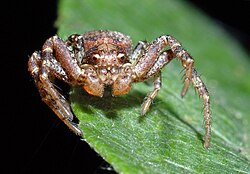Thomisidae
| Thomisidae | |
|---|---|
 |
|
| Ozyptila praticola | |
| Scientific classification | |
| Kingdom: | Animalia |
| Phylum: | Arthropoda |
| Subphylum: | Chelicerata |
| Class: | Arachnida |
| Order: | Araneae |
| Infraorder: | Araneomorphae |
| Family: |
Thomisidae Sundevall, 1833 |
| Genera | |
| Diversity | |
| 175 genera, 2,155 species | |
 |
|
See List of Thomisidae genera.
The Thomisidae are a family of spiders, including about 175 genera and over 2,100 species. The common name crab spider is often applied to species in this family, but is also applied loosely to many other species of spiders. Among the Thomisidae, "crab spider" refers most often to the familiar species of "flower crab spiders", though not all members of the family are limited to ambush hunting in flowers.
Rationalisation for the name crab spider is generally subjective and anecdotal. It is commonly said to refer to a fancied resemblance to crabs, or to the way such spiders hold their two front pairs of legs, or their ability to scuttle sideways or backwards. Some spiders so called have bodies that are flattened and angular. At all events, the Thomisidae are the family most generally referred to as "crab spiders". However, some members of the Sparassidae are called "giant crab spiders", the Selenopidae are called "wall crab spiders", and various members of the Sicariidae are sometimes called "six-eyed crab spiders". Some unrelated orb-weaver spider species such as Gasteracantha cancriformis also are commonly called "crab spiders".
Such names are of little biological significance, and the following emphasis is on the Thomisidae.
Thomisidae do not build webs to trap prey, though all of them produce silk for drop lines and sundry reproductive purposes; some are wandering hunters and the most widely known are ambush predators. Some species sit on or beside flowers or fruit, where they grab visiting insects. Individuals of some species, such as Misumena vatia, are able to change color over a period of some days, to match the flower on which they are sitting. Some species frequent promising positions among leaves or bark, where they await prey, and some of them sit in the open, where they are startlingly good mimics of bird droppings. However, these members of the family Thomisidae are not to be confused with the spiders that generally are called bird-dropping spiders, not all of which are close relatives of crab spiders.
...
Wikipedia
